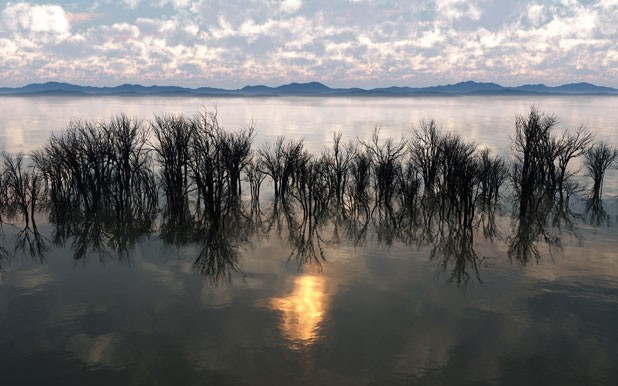
- "Flood"
Burlington artist John Douglas is flirting with metaphysics after a long liaison with politics — but he isn’t going all the way. His current show of digitally manipulated images at Furchgott Sourdiffe Gallery in Shelburne, titled “Stones &,” finds the septuagenarian artist and filmmaker focusing on what he describes as “virtual landscapes.”
In some of the 21 color prints on display, rocks float in formation in cloud-streaked skies over calm seas. A row of bare, probably dead trees stands partly submerged in the foreground of other watery scenes that open onto a distant horizon. In some images the distance is lined with mountains à la the Adirondacks across Lake Champlain. In other pieces composed with a similar set of horizontals, an urban skyline rims the far shore. The buildings’ shapes are reflected in water that’s milky and placid in “The Flood,” but is an ominous, fiery pink in “Change.”
The sky gives off the same flamelike glow in the latter piece, suggesting that an explosion may have just occurred. Reinforcing that reading, a pair of fighter jets streaks over the city’s towers.
Gallerygoers may respond to these digitally deft compositions much as desert travelers would to the sight of a pond shimmering amid the sands. In both cases, the rational mind knows the marvel to be a mirage. But that understanding doesn’t make the illusion any less real to the eye.
Douglas has clearly mastered the medium, but apparently completed this body of work only recently. A few of the prints are dated just days before the opening of his exhibit on April 19. Douglas’ range of subjects is also narrow, with several images riffing on a few templates, one of which — rocks in the sky — was made famous 60 years ago by the French surrealist René Magritte. It may be that Douglas has just begun exploring the theme of a natural world governed by alternate laws of physics.
He’s no newbie, however, to manipulating images on a computer. In his hilarious “Homeland Security” series from 2004 — pieces of which were shown at last year’s South End Art Hop — Douglas presents multiple images of his nude self in a single, large frame, an M16 semi-automatic rifle deployed to ensure the viewer isn’t exposed to the full monty. He’s shown scurrying around trees and flashing through fields seemingly on search-and-destroy missions. In another image from this series, several Douglases stand sentinel in front of the Statehouse in Montpelier.
The artist’s political, and satirical, intent is nakedly plain in “Homeland Security.” And it’s consistent with a career that includes a stint in the U.S. Army and work as an engagé filmmaker in New York City in the 1960s. Douglas was part of the Newsreel media collective that made documentaries in support of the civil-rights movement and in opposition to the Vietnam War.
That side of the artist can still be glimpsed at Furchgott Sourdiffe in the stack of cardboard notices piled on a shelf alongside the sign-in/comments book. In stenciled block lettering meant to resemble a “POSTED” sign, these warnings are headlined “NO KILLING OR ANY OTHER VIOLENCE,” and go on to specify “against any living being or bird or animal or Palestinian or Harvard graduate or black person on these premises or in fact anywhere even near this very area.”
In the body of “Stones &,” political messages are transmitted far more subtly. Airborne weapons of mass destruction, commonly referred to as fighter jets, appear in a few of the images, but only in the title of one work, “0 Dark F35,” are they the center of attention. Mostly, Douglas is looking at the world in elemental terms — rocks, water, sky — and altering its natural order to achieve formalist effects.
But the show still has a political agenda of sorts. Writing in the third person in an artist’s statement introducing “Stones &,” Douglas declares, “The beauty of our planet shows him the eternal possibilities of hope and evolution coexisting with the potential destruction of human life.” He goes on to posit a “planetary intelligence” that’s beyond human comprehension. “What do stones think?” Douglas wonders. “What do trees see? What does water truly reflect?”
Hints to answers might be found in “Roques,” in which a group of oval stones, viewed close-up, looks like eggs hatching. Something unimaginable seems about to emerge from the cracks in their surfaces. Maybe it’s the “terrible beauty” William Butler Yeats saw being born from the ashes of Irish rebels’ failed rising in his poem “Easter, 1916.”
“Stone &,” digital photographs by John Douglas, Furchgott Sourdiffe Gallery, Shelburne. Through May 21. fsgallery.com
The original print version of this article was headlined "Nature, Interrupted."









Comments
Comments are closed.
From 2014-2020, Seven Days allowed readers to comment on all stories posted on our website. While we've appreciated the suggestions and insights, right now Seven Days is prioritizing our core mission — producing high-quality, responsible local journalism — over moderating online debates between readers.
To criticize, correct or praise our reporting, please send us a letter to the editor or send us a tip. We’ll check it out and report the results.
Online comments may return when we have better tech tools for managing them. Thanks for reading.